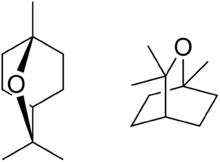أوكاليپتول

| |||
|
| |||
| الأسماء | |||
|---|---|---|---|
| اسم أيوپاك
1,3,3-Trimethyl-2-oxabicyclo[2,2,2]octane
| |||
| أسماء أخرى
1,8-Cineole
1,8-Epoxy-p-menthane | |||
| المُعرِّفات | |||
| رقم CAS | |||
3D model (JSmol)
|
|||
| ChEMBL | |||
| ChemSpider | |||
| DrugBank | |||
| ECHA InfoCard | 100.006.757 | ||
| KEGG | |||
PubChem CID
|
|||
| UNII | |||
CompTox Dashboard (EPA)
|
|||
| |||
| |||
| الخصائص | |||
| الصيغة الجزيئية | C10H18O | ||
| كتلة مولية | 154.249 گ/مول | ||
| الكثافة | 0.9225 گ/سم3 | ||
| نقطة الانصهار | |||
| نقطة الغليان | |||
ما لم يُذكر غير ذلك، البيانات المعطاة للمواد في حالاتهم العيارية (عند 25 °س [77 °ف]، 100 kPa). | |||
| مراجع الجدول | |||
الأوكاليپتول Eucalyptol، هو مركب عضوي طبيعي عبارة عن سائل عديم اللون. وهو إثير ومونوترين دوري.
يعرف الأوكاليپتول أيضاً بمرادفات مختلفة: 1، 8-سينيول، كاجپول، 1، 8-إپوكسي-پي-منثان، 1، 8-أكوسيدو-پي-ميثان، الأوكاليپتول، 1، 3، 3-ثلاثي الميثيل-2-أوكسابيسيكلو[2،2،2]اوكتانن سينيول.
عام 1870، حدد ف.س. كلويز وأطلق اسم الأوكاليپتول على الجزء السائد في زيت أوكاليپتوس گلوبولوس.[1] زيت الأوكاليپتوس، هو الاسم العام الذي يطلق على الزيتوت المستخرجة من جنس نباتات الأوكاليپتوس، والتي يجب عدم الخلط بينها وبين مركب الأوكاليپتول الكيميائي.
التركيب
الخصائص
الاستخدامات
النكهة والرائحة
الطبي
يستخدم الأوكاليپتول كمكون ضمن الكثير من أنواع غسولات الفم وأدوية السعال، فضلاً عن كونه مكون غير نشط في بودرة الجسم.
كطارد للحشرات
السمية
دراسات علمية
قائمة النباتات التي تحتوي على المادة الكيميائية
- القنب[2]
- الكافور، (50%)[3]
- Eucalyptus cneorifolia[بحاجة لمصدر]
- Eucalyptus dives[بحاجة لمصدر]
- Eucalyptus dumosa[بحاجة لمصدر]
- Eucalyptus globulus[4]
- Eucalyptus goniocalyx[بحاجة لمصدر]
- Eucalyptus horistes[بحاجة لمصدر]
- Eucalyptus kochii[بحاجة لمصدر]
- Eucalyptus leucoxylon[بحاجة لمصدر]
- Eucalyptus oleosa[بحاجة لمصدر]
- Eucalyptus polybractea[بحاجة لمصدر]
- Eucalyptus radiata[بحاجة لمصدر]
- Eucalyptus sideroxylon[بحاجة لمصدر]
- Eucalyptus smithii[بحاجة لمصدر]
- Eucalyptus staigeriana[5]
- Eucalyptus tereticornis[بحاجة لمصدر]
- Eucalyptus viridis[بحاجة لمصدر]
- Helichrysum gymnocephalum [6]
- Kaempferia galanga, Galangal, (5.7%)[7]
- Laurus nobilis، (45%)[بحاجة لمصدر]
- شجرة الشاي (0–15%)[بحاجة لمصدر]
- Salvia lavandulifolia، (13%)[8]
- Turnera diffusa [9]
- Umbellularia californica، (22.0%)[10]
- الزنجبيل[بحاجة لمصدر]
الوضع التركيبي
الكبرتة
انظر أيضاً
المصادر
- ^ Boland, D. J.; Brophy, J. J.; House, A. P. N. (1991). Eucalyptus Leaf Oils: Use, Chemistry, Distillation and Marketing. Melbourne: Inkata Press. p. 6. ISBN 0-909605-69-6.
- ^ "Cannabis and cannabis extracts: greater than the sum of their parts?". Journal of Cannabis Therapeutics. 1 (3–4): 103–132. 2001. doi:10.1300/J175v01n03_08. Retrieved 20 سبتمبر 2013.
{{cite journal}}: Cite uses deprecated parameter|authors=(help) - ^ Stubbs, B. J.; Brushett, D. (2001). "Leaf oil of Cinnamomum camphora (L.) Nees and Eberm. From Eastern Australia". Journal of Essential Oil Research. 13 (1): 51–54. doi:10.1080/10412905.2001.9699604.
{{cite journal}}: CS1 maint: multiple names: authors list (link) - ^ Maciel, M. V.; Morais, S. M.; Bevilaqua, C. M.; Silva, R. A.; Barros, R. S.; Sousa, R. N.; Sousa, L. C.; Brito, E. S.; Souza-Neto M. A. (2010). "Chemical composition of Eucalyptus spp. essential oils and their insecticidal effects on Lutzomyia longipalpis". Veterinary Parasitology. 167 (1): 1–7. doi:10.1016/j.vetpar.2009.09.053. PMID 19896276.
{{cite journal}}: CS1 maint: multiple names: authors list (link) - ^ Gilles, M.; Zhao, J.; An, M.; Agboola, S. (2010). "Chemical Composition and Antimicrobial Properties of Essential Oils of three Australian Eucalyptus Species". Food Chemistry. 119 (2): 731–737. doi:10.1016/j.foodchem.2009.07.021.
- ^ Möllenbeck, S.; König, T.; Schreier, P.; Schwab, W.; Rajaonarivony, J.; Ranarivelo, L. (1997). "Chemical Composition and Analyses of Enantiomers of Essential Oils from Madagascar". Flavour and Fragrance Journal. 12 (2): 63. doi:10.1002/(SICI)1099-1026(199703)12:2<63::AID-FFJ614>3.0.CO;2-Z.
- ^ Wong, K. C.; Ong, K. S.; Lim, C. L. (2006). "Composition of the Essential Oil of Rhizomes of Kaempferia Galanga L.". Flavour and Fragrance Journal. 7 (5): 263–266. doi:10.1002/ffj.2730070506.
- ^ "In-vitro inhibition of human erythrocyte acetylcholinesterase by salvia lavandulaefolia essential oil and constituent terpenes". J Pharm Pharmacol. 52 (7): 895–902. 2000. doi:10.1211/0022357001774598. PMID 10933142.
{{cite journal}}: Cite uses deprecated parameter|authors=(help) - ^ Balch, P. A. (2002). Prescription for Nutritional Healing: the A to Z Guide to Supplements. Penguin. p. 233. ISBN 978-1-58333-143-9.
- ^ Kelsey, R. G.; McCuistion, O.; Karchesy, J. (2007). "Bark and Leaf Essential Oil of Umbellularia californica, California Bay Laurel, from Oregon". Natural Product Communications. 2 (7): 779–780.
{{cite journal}}: CS1 maint: multiple names: authors list (link) - ^ The British Pharmacopoeia Secretariat (2009). "Index, BP 2009" (PDF). Retrieved 5 يوليو 2009.
- ^ Therapeutic Goods Administration. "Chemical Substances" (PDF). tga.gov.au. Archived from the original (PDF) on 2 يوليو 2009. Retrieved 5 يوليو 2009.
قراءات إضافية
- Boland, D. J.; Brophy, J. J.; House, A. P. N. (1991). Eucalyptus Leaf Oils: Use, Chemistry, Distillation and Marketing. Melbourne: Inkata Press. ISBN 0-909605-69-6.
وصلات خارجية
- "Eucalyptus". Botanical.com.
- "Oleum Eucalypti, B.P. Oil of Eucalyptus". Henriette's Herbal.
- "MSDS - Safety data for eucalyptol". Oxford University Chemistry Department.[dead link]
This article contains content from Wikimedia licensed under CC BY-SA 4.0. Please comply with the license terms.
تصنيفات:
- CS1 errors: deprecated parameters
- Pages using Chembox with unknown parameters
- ECHA InfoCard ID from Wikidata
- Articles containing unverified chemical infoboxes
- Short description is different from Wikidata
- Articles with unsourced statements from January 2010
- Articles with unsourced statements from December 2010
- Articles with dead external links from January 2012
- Use dmy dates from July 2011
- Portal-inline template with redlinked portals
- Pages with empty portal template
- منكهات مبردة
- Monoterpenes
- إثيرات
- إپوكسيدات


